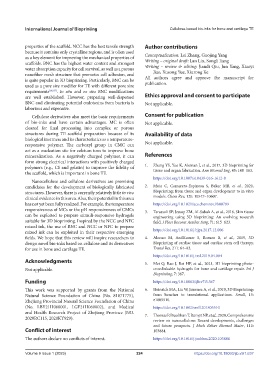Page 232 - IJB-9-1
P. 232
International Journal of Bioprinting Cellulose-based bio-inks for bone and cartilage TE
properties of the scaffold. NCC has the best tensile strength Author contributions
because it contains only crystalline regions, and is often used Conceptualization: Lei Zhang, Guojing Yang
as a key element for improving the mechanical properties of Writing – original draft: Lan Lin, Songli Jiang
scaffolds. BNC has the highest water content and strongest Writing – review & editing: Jiandi Qiu, Jun Yang, Xiaoyi
water absorption capacity for cell survival, as well as a porous Jiao, Xusong Yue, Xiurong Ke
nanofiber mesh structure that promotes cell adhesion, and All authors agree and approve the manuscript for
is quite popular in 3D bioprinting. Particularly, BNC can be publication.
used as a pore size modifier for TE with different pore size
requirements [96,97] . In situ and ex situ BNC modifications
are well established. However, preparing well-dispersed Ethics approval and consent to participate
BNC and eliminating potential endotoxins from bacteria is Not applicable.
laborious and expensive.
Cellulose derivatives also meet the basic requirements Consent for publication
of bio-inks and have certain advantages. MC is often Not applicable.
cleared for final processing into complex or porous
structures during TE scaffold preparation because of its Availability of data
biological inertness and its characteristics as a temperature-
responsive polymer. The carboxyl group in CMC can Not applicable.
act as a nucleation site for calcium ions to improve bone
mineralization. As a negatively charged polymer, it can References
form strong electrical interactions with positively charged
polymers (e.g., CS and gelatin) to improve the fidelity of 1. Zhang YS, Yue K, Aleman J, et al., 2017, 3D bioprinting for
tissue and organ fabrication. Ann Biomed Eng, 45: 148–163.
the scaffold, which is important in bone TE.
https://doi.org/10.1007/s10439-016-1612-8
Nanocellulose and cellulose derivatives are promising
candidates for the development of biologically fabricated 2. Mota C, Camarero-Espinosa S, Baker MB, et al., 2020,
structures. However, there is currently relatively little in vivo Bioprinting: from tissue and organ development to in vitro
clinical evidence in this area. Also, their potential in this area models. Chem Rev, 120: 10547–10607.
has not yet been fully realized. For example, the temperature https://doi.org/10.1021/acs.chemrev.9b00789
responsiveness of MCs or the pH responsiveness of CMCs 3. Tarassoli SP, Jessop ZM, Al-Sabah A, et al., 2018, Skin tissue
can be exploited to prepare stimuli-responsive hydrogels engineering using 3D bioprinting: An evolving research
suitable for 3D bioprinting. Inspired by the NCC and NFC field. J Plast Reconst Aesthet Surg, 71: 615–623.
mixed ink, the use of BNC and NCC or NFC to prepare
mixed ink can be exploited in their respective emerging https://doi.org/10.1016/j.bjps.2017.12.006
fields. We hope that this review will inspire researchers to 4. Alonzo M, AnilKumar S, Roman B, et al., 2019, 3D
design novel bio-inks based on cellulose and its derivatives Bioprinting of cardiac tissue and cardiac stem cell therapy.
for use in bone and cartilage TE. Transl Res, 211: 64–83.
https://doi.org/10.1016/j.trsl.2019.04.004
Acknowledgments 5. Mei Q, Rao J, Bei HP, et al., 2021, 3D bioprinting photo-
Not applicable. crosslinkable hydrogels for bone and cartilage repair. Int J
Bioprinting, 7: 367.
Funding https://doi.org/10.18063/ijb.v7i3.367
This work was supported by grants from the National 6. Heinrich MA, Liu W, Jimenez A, et al., 2019, 3D Bioprinting:
Natural Science Foundation of China (No. 81871775), from benches to translational applications. Small, 15:
Zhejiang Provincial Natural Science Foundation of China e1805510.
(No. LBY21H060001, LGF21H060002), and Medical https://doi.org/10.1002/smll.201805510
and Health Research Project of Zhejiang Province (NO. 7. Thomas P, Duolikun T, Rumjit NP, et al., 2020, Comprehensive
2020RC115, 2020KY929).
review on nanocellulose: Recent developments, challenges
and future prospects. J Mech Behav Biomed Mater, 110:
Conflict of interest 103884.
The authors declare no conflicts of interest. https://doi.org/10.1016/j.jmbbm.2020.103884
V
Volume 9 Issue 1 (2023)olume 9 Issue 1 (2023) 224 https://doi.org/10.18063/ijb.v9i1.637

